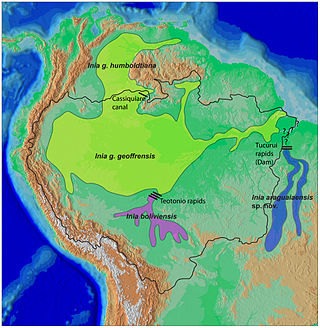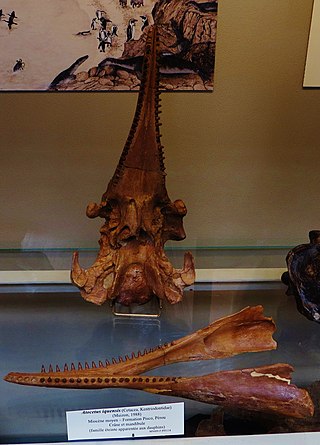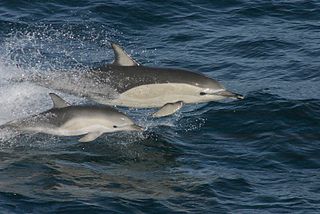
River dolphins are a polyphyletic group of fully aquatic mammals that reside exclusively in freshwater or brackish water. They are an informal grouping of dolphins, which itself is a paraphyletic group within the infraorder Cetacea. Extant river dolphins are placed in two superfamilies, Platanistoidea and Inioidea. They comprise the families Platanistidae, the recently extinct Lipotidae, Iniidae and Pontoporiidae. There are five extant species of river dolphins. River dolphins, alongside other cetaceans, belong to the clade Artiodactyla, with even-toed ungulates, and their closest living relatives the hippopotamuses, from which they diverged about 40 million years ago. Specific types of dolphins can be pink.

Iniidae is a family of river dolphins containing one living genus, Inia, and four extinct genera. The extant genus inhabits the river basins of South America, but the family formerly had a wider presence across the Atlantic Ocean.

Platanistidae is a family of river dolphins containing the extant Ganges river dolphin and Indus river dolphin but also extinct relatives from freshwater and marine deposits in the Neogene.
Kentriodon is an extinct genus of toothed whale related to modern-day dolphins. Fossils have been found in North America, Europe and Japan. Several species have been described.

The baiji is a possibly extinct species of freshwater dolphin native to the Yangtze river system in China. It is thought to be the first dolphin species driven to extinction due to the impact of humans. This dolphin is listed as “critically endangered: possibly extinct” by the IUCN, has not been seen in 40 years, and several surveys of the Yangtze have failed to find it. In China, the species is also called the Chinese river dolphin, Han river dolphin, Yangtze dolphin and whitefin dolphin. Nicknamed the "Goddess of the Yangtze", it was regarded as the goddess of protection by local fishermen and boatmen. It is not to be confused with the Chinese white dolphin or the finless porpoise. This is the only species in the genus Lipotes.

Kentriodontidae is an extinct family of odontocete whales related to modern dolphins. The Kentriodontidae lived from the Oligocene to the Pliocene before going extinct.
Meherrinia is an extinct genus of inioid river dolphin from the Meherrin River, North Carolina, in the United States. First described in 2012, the dolphin is, in most respects, intermediate in form between the living Amazon river dolphin and the La Plata dolphin, although it is probably more closely related to the former. However, the fossil was discovered in what are believed to be marine deposits, dating from the late Miocene, whereas the Amazon river dolphin is an exclusively freshwater species. Meherrinia therefore was, as of 2012, the only known marine genus of the family Iniidae, although others have been discovered since. Only one species is known.

Atocetus is an extinct genus of pontoporiid dolphin found in Miocene-age marine deposits in Peru and California.
Zarhinocetus is an extinct genus of whale from the Early to Middle Miocene of the eastern North Pacific.
Allodelphinidae is a family of primitive platanistoid river dolphins found in marine deposits in the eastern North Pacific region, Alaska, and Japan.
Macrokentriodon is an extinct genus of giant dolphin once assigned to the paraphyletic/polyphyletic family Kentriodontidae. Remains have been found in the late Miocene (Serravallian) Choptank Formation of United States.
Liolithax is an extinct genus of dolphin from the Middle Miocene (Serravallian) Temblor Formation of California.

Lophocetus is an extinct genus of dolphin belonging to the clade Delphinida that is known from late Miocene (Tortonian) marine deposits in California and Maryland. Although usually placed in Kentriodontidae, recent studies have found it only distantly related to Kentriodon.
Hadrodelphis is an extinct genus of dolphin once assigned to the paraphyletic/polyphyletic family Kentriodontidae. Remains have been found in the middle Miocene (Langhian) Calvert Formation of United States.
Brujadelphis is an extinct genus of river dolphin-like cetaceans of uncertain family placement from the Late Miocene epoch (Serravallian) of present-day Peru. The type species is Brujadelphis ankylorostris, recovered from the Pisco Formation.
Tagicetus is an extinct genus of dolphin belonging to the polyphyletic family Kentriodontidae.
Pomatodelphis is an extinct genus of river dolphin from Middle Miocene marine deposits in Alabama, Florida, Brazil, Germany and France.

Delphinida is a clade of cetaceans in the parvorder Odontoceti, the toothed whales. It includes all modern oceanic dolphins, porpoises, and their relatives, such as Lipotidae and Iniidae.
Eolipotes is an extinct genus of marine "river dolphin" of the family Lipotidae. It is the oldest known member of the family, having lived in what is now Japan during the Tortonian stage of the Late Miocene. Fossils of this animal are known from the Tochigi prefecture and the Gunma prefecture. Eolipotes was a small cetacean, with the skull indicating a length of around 2.17 m. In spite of its name, Eolipoteshas been found to be more closely related to the genus Parapontoporia, which could indicate that some species of Paraprotoporia and the baiji became freshwater animals independently from one another. However it is also possible that they all evolved from ancestors that already inhabited estuaries, with Eolipotes simply becoming more marine. The genus only includes a single species: E. japonicus.








